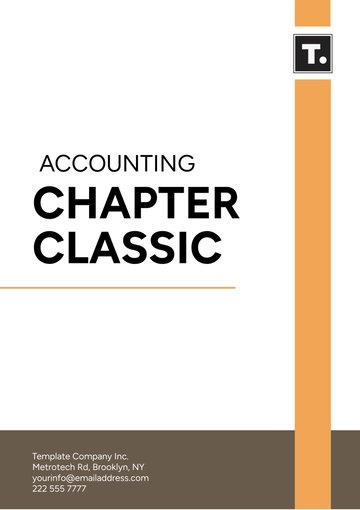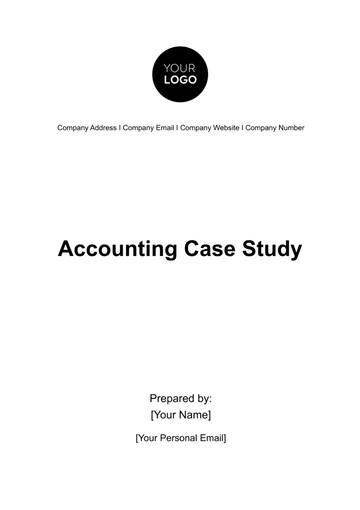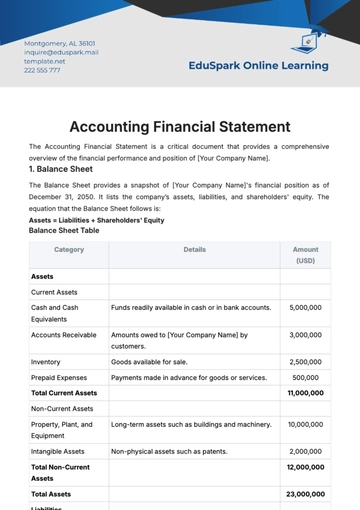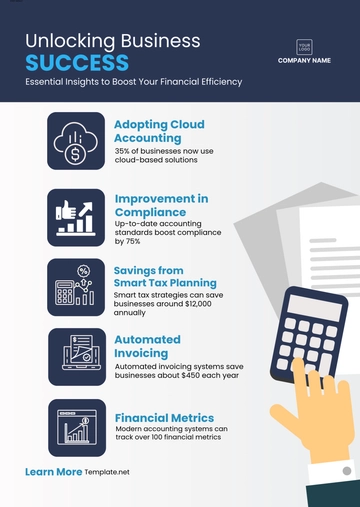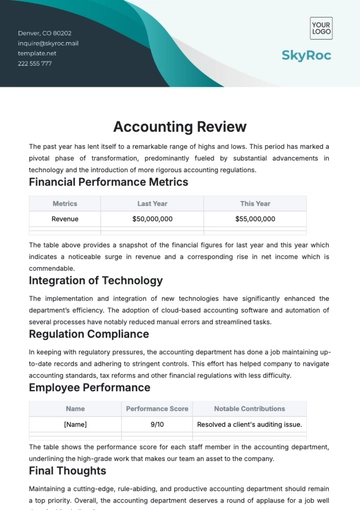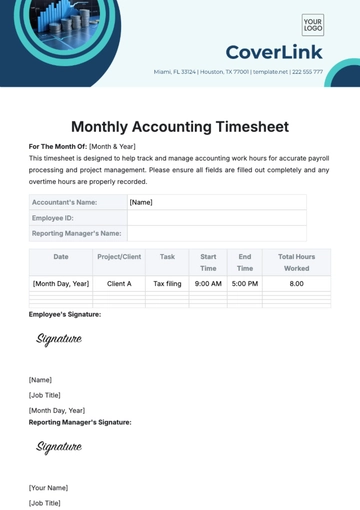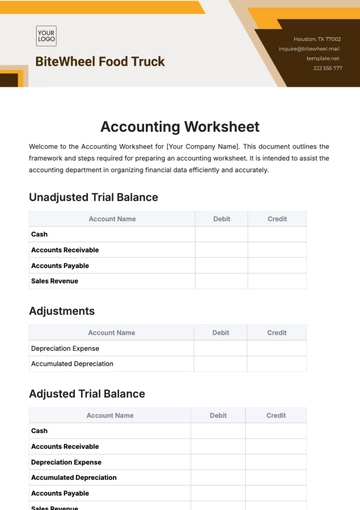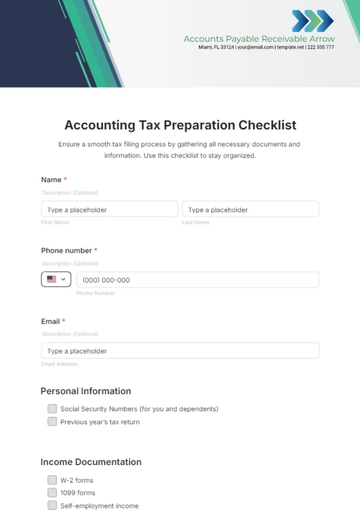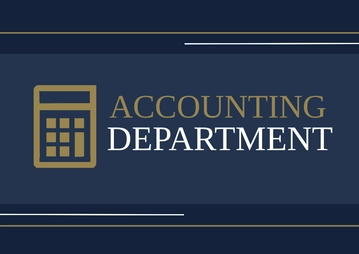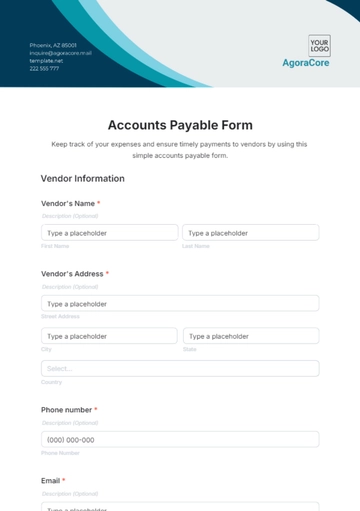Free Accounting Asset Valuation Impact Study
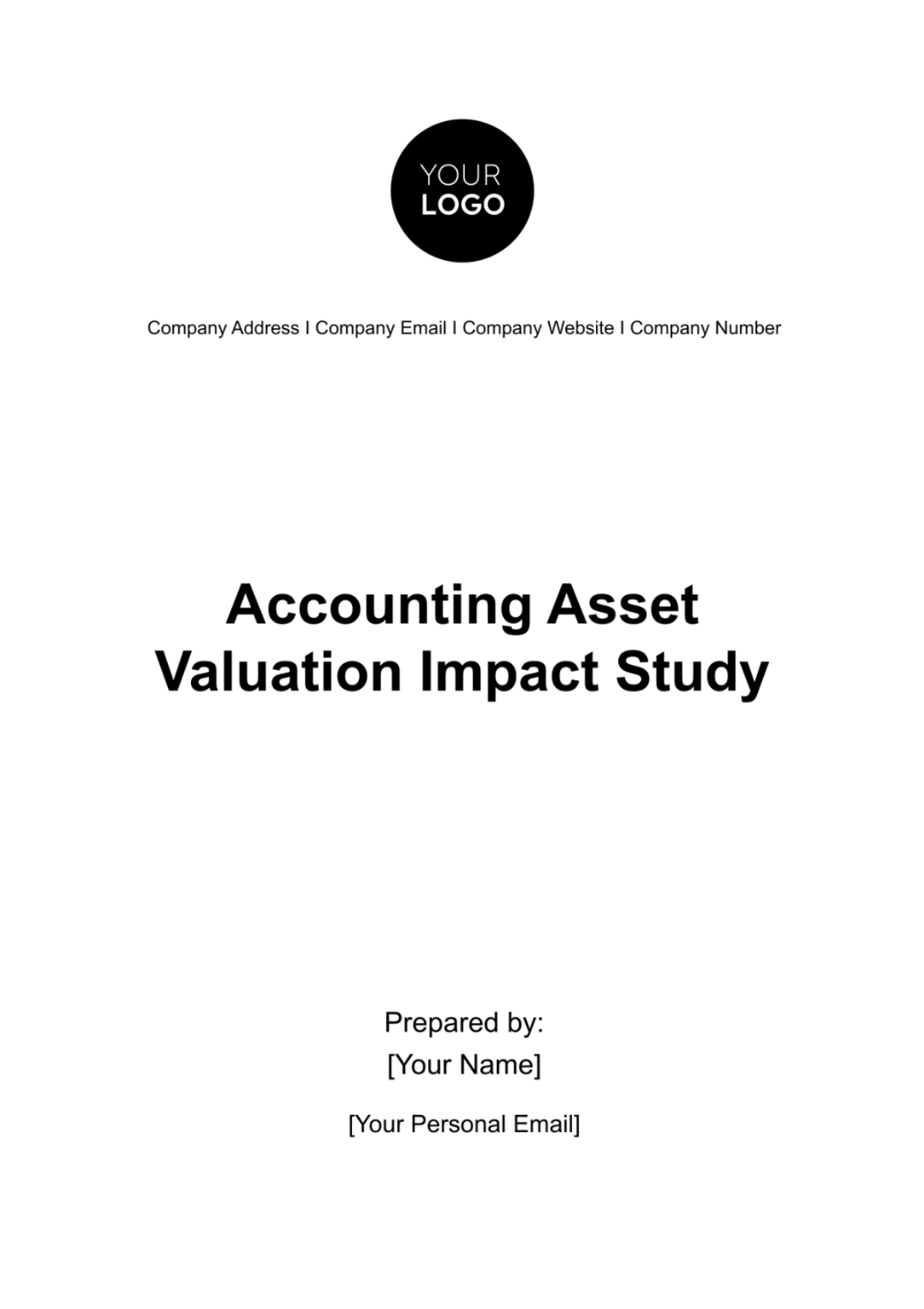
Executive Summary
The primary objective of this Asset Valuation Impact Study is to evaluate the effects of various asset valuation methods on our organization's financial statements and overall financial health. By comprehensively analyzing the implications of applying different valuation techniques, we aim to identify the most suitable approach that aligns with our strategic financial objectives, ensures regulatory compliance, and optimizes our tax obligations.
Key Findings
Our study meticulously examined several asset valuation methods, including the Historical Cost Method, Market Value Method, Income Approach, Replacement Cost Method, and Fair Value Method. Through hypothetical scenarios and financial modeling, we discovered that:
Depreciation Method Impact: The choice of depreciation method (Straight-Line vs. Reducing Balance) significantly affects our income statement, particularly in terms of reported earnings. For instance, adopting the Straight-Line method resulted in a smoother expense distribution over time, whereas the Reducing Balance method led to higher initial expenses but lower subsequent costs.
Balance Sheet Variability: Asset valuation methods such as the Fair Value Method introduced more variability to our balance sheet, reflecting market conditions more accurately but also increasing volatility in reported asset values.
Tax Implications: The choice of asset valuation method impacted our tax liabilities. For example, using the Replacement Cost Method for certain assets resulted in higher upfront costs but provided tax benefits in the form of depreciation deductions over time.
Financial Ratios: Asset valuation methods had a notable effect on key financial ratios. The use of the Market Value Method, for instance, improved our asset turnover ratio by reflecting a more realistic current value of assets, enhancing the attractiveness of our financial health to investors and creditors.
Recommendations
Based on our findings, we recommend the following strategic approaches to asset valuation:
Adopt a Mixed Valuation Approach: Utilize the Historical Cost Method for stable, long-term assets where market prices are less relevant, and the Fair Value Method for market-sensitive assets to accurately reflect current values.
Strategic Depreciation Policy: Implement the Straight-Line depreciation method for assets with consistent utility over their useful life, and the Reducing Balance method for assets experiencing rapid technological obsolescence, optimizing tax benefits and financial statement representation.
Regular Asset Revaluation: For assets valued using the Market Value or Fair Value Methods, conduct regular revaluations to ensure financial statements accurately reflect the current market conditions, enhancing transparency and investor confidence.
Enhanced Disclosure: Improve disclosures related to asset valuation methods and their financial impact in our annual reports, providing stakeholders with a clear understanding of our asset management strategies and their implications on our financial statements.
Purpose
The purpose of this Asset Valuation Impact Study is to critically assess how different asset valuation methods influence our organization's financial reporting, compliance with accounting standards, tax liabilities, and overall financial strategy. In an ever-evolving economic landscape, it is imperative for our organization to adopt asset valuation practices that not only adhere to regulatory requirements but also reflect the true economic value of our assets, thereby supporting informed decision-making and strategic financial planning.
Scope
The scope of this study encompasses a comprehensive analysis of various asset valuation methods, including but not limited to the Historical Cost Method, Market Value Method, Income Approach, Replacement Cost Method, and Fair Value Method. We examine the impact of these methods across several dimensions:
Financial Statements: Analyzing how each valuation method affects the balance sheet, income statement, and cash flow statement.
Tax Implications: Evaluating the impact on tax liabilities and opportunities for tax optimization.
Compliance and Regulatory Framework: Ensuring alignment with International Financial Reporting Standards (IFRS) and Generally Accepted Accounting Principles (GAAP).
Strategic Financial Planning: Assessing the implications for asset management, investment decisions, and risk management.
This study is focused on tangible fixed assets, such as property, plant, and equipment, and selected intangible assets, considering their significant role in our organization's asset portfolio.
Methodology
Our approach to this study is both quantitative and qualitative, involving:
Quantitative Analysis: Utilizing hypothetical financial models to simulate the impact of different asset valuation methods on our financial statements. This includes the creation of scenarios reflecting various economic conditions and asset performance outcomes.
Qualitative Assessment: Evaluating the strategic implications of each valuation method, considering factors such as market volatility, asset liquidity, and the economic lifecycle of assets. This assessment also takes into account regulatory compliance and the potential for financial statement manipulation.
Comparative Analysis: Drawing comparisons between the outcomes of different valuation methods, highlighting the advantages and limitations of each approach in the context of our organization's financial and operational objectives.
Stakeholder Consultation: Engaging with key internal stakeholders, including finance and accounting teams, to gather insights and perspectives on the practical implications of adopting various asset valuation methods.
Overview of Asset Valuation Methods
Asset valuation is a critical aspect of accounting and financial management, affecting how assets are reported and managed. This section provides an overview of the principal asset valuation methods used in accounting and their implications for financial reporting and decision-making.
Historical Cost Method
The Historical Cost Method values an asset based on its original purchase price, including any related acquisition costs. This method does not account for changes in market value after the asset is acquired. It offers simplicity and certainty, ensuring that assets are recorded at a consistent value. However, it may not reflect the current economic value of an asset, potentially leading to a misrepresentation of an organization's financial health over time.
Market Value Method
The Market Value Method, also known as the fair market value method, values assets based on their current market price. This method is most applicable to securities and other assets where market prices are readily available. While it ensures that asset valuations are current and reflective of market conditions, it can introduce volatility into financial statements due to market fluctuations.
Income Approach
The Income Approach values an asset based on the present value of the cash flows it is expected to generate over its useful life. This method is particularly useful for valuing intangible assets and investments that do not have a clear market price but are expected to produce future economic benefits. It requires assumptions about future income streams and appropriate discount rates, introducing a level of estimation and uncertainty.
Replacement Cost Method
The Replacement Cost Method values an asset based on the cost of replacing it with a new asset of similar functionality and condition. This approach is useful for insurance purposes and in situations where market values are not readily available. It reflects the current cost of maintaining operational capacity but may not always align with the market value or economic usefulness of the asset.
Fair Value Method
The Fair Value Method values assets and liabilities based on the price that would be received to sell an asset or paid to transfer a liability in an orderly transaction between market participants at the measurement date. This method combines elements of market value, income potential, and replacement cost to provide a comprehensive valuation. It is widely used in financial reporting to ensure that asset valuations accurately reflect current market conditions.
Depreciation Methods and Their Impact
Depreciation Method | Impact |
Straight-Line | Spreads the cost of an asset evenly over its useful life. Provides consistent expense recognition but may not match the asset's usage pattern. |
Reducing Balance | Accelerates depreciation expense early in the asset's life, with decreasing expenses over time. Reflects the declining productivity or utility of certain assets but can distort short-term earnings. |
Units of Production | Ties depreciation to the usage or production levels of an asset. Aligns expense recognition with the asset's economic benefits but requires accurate usage tracking. |
Sum-of-the-Years' Digits | A more accelerated method than straight-line but less so than reducing balance. Depreciation expense decreases each year, reflecting a faster decline in asset utility initially. |
Regulatory Framework and Standards
The selection and application of asset valuation methods are not only strategic financial decisions but also must comply with established regulatory frameworks and standards. These frameworks ensure consistency, transparency, and comparability in financial reporting across jurisdictions and sectors. This section explores the key regulatory standards governing asset valuation and their implications.
International Financial Reporting Standards (IFRS)
IFRS, developed by the International Accounting Standards Board (IASB), sets out globally accepted financial reporting guidelines. Key standards relevant to asset valuation include:
IAS 16 Property, Plant and Equipment: This standard prescribes the accounting treatment for property, plant, and equipment, including the choice of cost model or revaluation model for subsequent measurement.
IAS 38 Intangible Assets: Outlines the treatment for recognizing, measuring, and disclosing intangible assets, allowing for either a cost model or a revaluation model based on fair value.
IFRS 13 Fair Value Measurement: Provides guidance on how to determine the fair value of assets and liabilities, emphasizing the market-based approach.
Compliance with IFRS ensures that our financial statements are internationally comparable, enhancing the credibility and transparency of our financial disclosures.
Generally Accepted Accounting Principles (GAAP)
In the United States, GAAP is the framework of accounting standards, rules, and procedures defined by the Financial Accounting Standards Board (FASB). GAAP guidelines relevant to asset valuation include:
ASC 820 Fair Value Measurements and Disclosures: Similar to IFRS 13, this standard defines fair value, establishes a framework for measuring fair value, and requires disclosures about fair value measurements.
ASC 360 Property, Plant, and Equipment: Governs the accounting treatment for real estate, property, and equipment, focusing on historical cost for asset measurement and specific guidance on impairment losses and asset disposals.
GAAP ensures that financial reporting is consistent and transparent within the U.S., facilitating the assessment and comparison of financial health and operational performance.
Tax Implications of Asset Valuation
The choice of asset valuation and depreciation methods also has significant tax implications, affecting the timing and amount of tax deductions for depreciation and amortization. Tax authorities typically have specific rules regarding the valuation of assets for tax purposes, often requiring the use of historical cost for tax depreciation calculations. However, certain jurisdictions may allow or require adjustments to asset values for tax purposes, impacting an organization's taxable income and tax liabilities.
Accelerated Depreciation: Tax codes in many jurisdictions permit accelerated depreciation methods for tax reporting, allowing businesses to claim higher depreciation expenses in the early years of an asset's life, thus reducing taxable income.
Revaluation for Tax Purposes: In some cases, tax authorities may allow or require assets to be revalued, affecting capital gains tax calculations upon disposal of the asset.
Impact Analysis on Financial Statements
The choice of asset valuation and depreciation methods significantly influences an organization's financial statements. This section examines how different valuation methods affect the balance sheet, income statement, and cash flow statement, utilizing hypothetical figures to illustrate these impacts.
Effect on Balance Sheet
Component | Historical Cost | Market Value | Replacement Cost | Fair Value |
Asset Valuation | $500,000 | $550,000 | $530,000 | $560,000 |
Equity Impact | Neutral | Increase | Increase | Increase |
Liabilities Impact | Neutral | Neutral | Neutral | Neutral |
Asset Valuation and Equity: The Market Value, Replacement Cost, and Fair Value methods typically result in higher asset valuations compared to the Historical Cost method, potentially increasing equity through higher retained earnings (assuming assets are revalued upwards). This effect is seen in the hypothetical figures where market-based valuations exceed the historical cost.
Asset Valuation and Liabilities: Liabilities are generally not directly affected by the choice of asset valuation method; however, higher asset valuations can indirectly impact certain financial ratios, influencing borrowing capacity.
Effect on Income Statement
Component | Historical Cost | Market Value | Replacement Cost | Fair Value |
Depreciation Expense | $10,000 | $11,000 | $10,600 | $11,200 |
Asset Impairment Charges | - | $2,000 | - | $1,500 |
Depreciation Expense: Depreciation expenses vary across methods, affecting net income. The Market Value and Fair Value methods can lead to higher depreciation expenses due to higher asset valuations, as demonstrated in the hypothetical figures.
Asset Impairment Charges: Market Value and Fair Value methods may require recognition of impairment losses if the market value of an asset decreases significantly, further impacting net income.
Effect on Cash Flow Statement
Component | Historical Cost | Market Value | Replacement Cost | Fair Value |
Operational Cash Flows | Neutral | Neutral | Neutral | Neutral |
Investment Cash Flows | $50,000 | $45,000 | $47,000 | $44,000 |
Operational Cash Flows: The choice of valuation method does not directly affect operational cash flows, as these are primarily concerned with cash received and spent during normal business operations. However, higher depreciation expenses under certain valuation methods can lower taxable income, potentially reducing cash outflows for income taxes.
Investment Cash Flows: Investment cash flows may be affected by the purchase, sale, or upgrade of assets, which can vary with different valuation methods. For instance, using the Market Value or Fair Value method might result in higher asset purchase costs, as indicated by the hypothetical investment cash flows.
Case Studies
This section presents case studies to illustrate the practical implications of different asset valuation methods, industry-specific valuation practices, and the impact of asset revaluation on financial ratios. These real-world examples underscore the importance of choosing the appropriate valuation method in various contexts.
Case Study: Tech Company A
Tech Company A recently acquired cutting-edge technology equipment. Given the rapid obsolescence rate of technology, the company faced a decision on which asset valuation method to apply.
Valuation Method | Asset Value | Depreciation Expense | Net Income Impact |
Historical Cost | $1,000,000 | $100,000 | Neutral |
Replacement Cost | $1,200,000 | $120,000 | Decrease |
Fair Value | $900,000 | $90,000 | Increase |
Findings: Opting for the Fair Value method allowed Tech Company A to better reflect the current market conditions, reducing depreciation expense and positively impacting net income. This decision was particularly beneficial given the high rate of technology turnover.
Industry-Specific Valuation Practices
Case Study: Real Estate Firm B
Real Estate Firm B specializes in commercial properties, which tend to appreciate over time. The firm needed to decide how best to reflect this appreciation in its financial statements.
Valuation Method | Asset Value | Equity Impact | Market Perception |
Historical Cost | $5,000,000 | Neutral | Conservative |
Market Value | $7,000,000 | Increase | Positive |
Findings: By applying the Market Value method, Real Estate Firm B was able to more accurately represent the value of its assets, boosting equity and improving market perception, crucial for attracting investors.
Impact of Asset Revaluation on Financial Ratios
Case Study: Manufacturing Company C
Manufacturing Company C underwent a revaluation of its plant and machinery to reflect current market conditions. The revaluation had a significant impact on its financial ratios.
Financial Ratio | Before Revaluation | After Revaluation |
Asset Turnover | 0.5 | 0.4 |
Return on Assets (ROA) | 10% | 8% |
Findings: The revaluation increased the total asset base of Manufacturing Company C, leading to a decrease in asset turnover and ROA. While these changes might seem negative, they more accurately reflected the company's operational efficiency and asset utilization in line with current market values.
These case studies demonstrate the nuanced considerations that must be made when selecting asset valuation methods. The choice of method can significantly affect financial reporting, tax liabilities, and investor perceptions, underscoring the need for strategic decision-making tailored to the organization's specific industry and asset characteristics.
Strategic Implications
The adoption of various asset valuation methods carries profound strategic implications for an organization's financial health, risk management practices, and investment and financing decisions. This section delves into how the strategic application of these methods can enhance organizational value and ensure long-term sustainability.
Asset Valuation and Financial Health
Asset valuation directly impacts an organization's balance sheet, influencing perceived financial health and stability. Accurate asset valuation is crucial for:
Reflecting True Asset Value: Methods like the Fair Value or Market Value approach ensure assets are recorded at values closely aligned with current market conditions, providing a realistic view of the organization’s financial standing.
Optimizing Equity Value: Higher asset valuations can increase equity, improving key financial ratios and potentially enhancing the organization's attractiveness to investors and creditors.
Financial Reporting Accuracy: Compliance with IFRS or GAAP through appropriate asset valuation enhances the accuracy of financial reporting, fostering trust among stakeholders.
Risk Management
Asset valuation methods also play a critical role in risk management, particularly in terms of asset depreciation and impairment risks:
Depreciation Method Selection: Choosing the right depreciation method (e.g., Straight-Line vs. Reducing Balance) can help manage the risk of overvaluing assets, ensuring that asset values on the balance sheet gradually decrease in a manner that mirrors their declining usefulness and economic benefits.
Impairment Testing: Regular asset valuation, especially using the Fair Value method, facilitates timely recognition of impairments, allowing organizations to adjust their financial statements accordingly and manage the risk of asset overvaluation.
Investment and Financing Decisions
The approach to asset valuation influences investment decisions and financing strategies by:
Guiding Capital Allocation: Valuation methods that provide a realistic assessment of asset values can guide organizations in making informed capital allocation decisions, prioritizing investments that offer the best return on investment.
Influencing Financing Strategies: Asset valuations affect an organization’s borrowing capacity, as assets often serve as collateral for loans. Higher asset valuations may improve loan terms and access to credit.
Attracting Investment: Transparent and market-reflective asset valuation can make an organization more attractive to potential investors, who rely on accurate financial information to make investment decisions.
Recommendations
Given the complexities and strategic implications of asset valuation, it is imperative for organizations to adopt tailored approaches that align with their specific needs, regulatory requirements, and strategic goals. Below are recommendations designed to optimize asset management practices.
Tangible Fixed Assets (e.g., Property, Plant, Equipment): Employ the Historical Cost Method for stability, supplementing with the Fair Value Method for periodic revaluation to reflect market conditions and ensure relevance in financial reporting.
Intangible Assets (e.g., Patents, Trademarks): Use the Income Approach to capture the future economic benefits these assets are expected to generate, offering a valuation that reflects their true potential to the organization.
Highly Liquid Assets (e.g., Marketable Securities): Apply the Market Value Method to align the valuation with current market conditions, ensuring the balance sheet accurately reflects their realizable value.
Adopt a Method that Reflects Asset Usage: Choose depreciation and amortization methods that best mirror the asset's usage pattern and economic benefits. For example, the Units of Production method for manufacturing equipment.
Regular Review of Asset Lives and Residual Values: Periodically reassess the useful lives and residual values of assets to ensure depreciation and amortization charges accurately reflect their consumption of economic benefits.
Implement Impairment Testing Procedures: Establish rigorous processes for testing asset impairments, particularly for intangible assets with indefinite lives, ensuring timely recognition of impairment losses.
Stay Informed on Regulatory Changes: Regularly monitor updates to accounting standards (IFRS, GAAP) and tax laws that impact asset valuation, ensuring ongoing compliance.
Enhance Disclosure Practices: Provide comprehensive disclosures in financial statements regarding asset valuation methods, assumptions used, and the impact of revaluations or impairments, fostering transparency and stakeholder trust.
Adopt Conservative Valuation Practices: Where uncertainty exists, adopt a conservative approach to asset valuation and depreciation to mitigate the risk of significant adjustments or non-compliance in the future.
Conclusion
This Asset Valuation Impact Study has underscored the significant influence that asset valuation methods exert on financial reporting, tax liabilities, and strategic decision-making. Through comparative analysis, industry-specific case studies, and an exploration of strategic implications, it is evident that no one-size-fits-all approach exists. Instead, the optimal method varies depending on the asset type, organizational objectives, and the prevailing economic environment.
Looking ahead, asset valuation will continue to evolve in response to technological advancements, changes in market dynamics, and regulatory updates. Organizations must remain agile, continuously reassessing their asset valuation practices to ensure they reflect the true economic value of assets while adhering to the highest standards of financial reporting and compliance. Embracing innovative valuation techniques and technologies will be key to enhancing accuracy, efficiency, and strategic insight in asset management practices.
- 100% Customizable, free editor
- Access 1 Million+ Templates, photo’s & graphics
- Download or share as a template
- Click and replace photos, graphics, text, backgrounds
- Resize, crop, AI write & more
- Access advanced editor
Enhance your financial analysis with the Accounting Asset Valuation Impact Study Template from Template.net. This indispensable tool is completely editable and customizable, designed to meticulously assess the impacts of asset valuation. With the capability to be editable in our AI Editor tool, it enables precise customization to align with your unique analytical needs. It's the ultimate resource for conducting detailed valuation impact studies in accounting.





